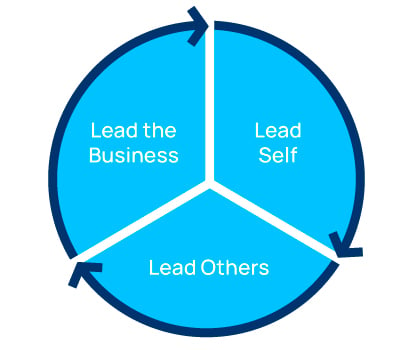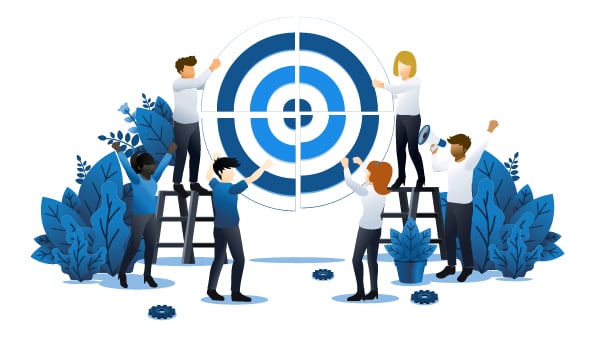Mapping the Journey
Implement a competency-based talent strategy in your organization by using this journey analogy to build buy-in.
This 4-step, Personalized Talent Management process will deliver exceptional results through a talent strategy that is Personal, Strategic and Measurable.
Organizations need a better way to develop the skills and drive the performance that delivers results. The 4-step, Personalized Talent Management process below will deliver exceptional results through a talent strategy that is Personal, Strategic and Measurable.
1. Define – define which skills and goals are critical to delivering exceptional results
2. Measure – measure through assessments / reviews to identify critical gaps and track progress
3. Plan – plan development efforts using data to determine the highest pay-off opportunities in alignment with business goals
4. Develop – develop using a cadence for learners and managers that keeps them focused on the critical skills / outcomes
In this article, we will show you how to structure and implement this personalized approach to talent management so that it will deliver exceptional results at every level of your organization.
The Challenge – what is really at stake and why it is so important that you take action
Not The Answer – a few of the popular ways to approach skill development and why they fall short of what you really need
The Solution – the 4-steps required to implement the Personalized Talent Management process in your organization
Where To Start – how to start small and build buy-in and momentum at the same time
Make It Easy – if you love the outcome, but the process sounds tedious, let us help
It all comes down to one fundamental question – does your workforce have the skills and know the goals that are required to deliver exceptional results? Today? Tomorrow? 5 years from now?
Likely not. Training Magazine estimates that skills learned today remain relevant for an average of only five years. This is because the skills required to succeed in business today are changing at an unprecedented rate. Let’s assume for a moment that they do have the skills. Do they have the goal clarity to effectively put those skills to work? If you can’t help them keep up, first your workforce and then your organization will pay the price.

We can point to the obvious drivers like the Coronavirus pandemic or when your leadership changes strategy, but what about the not-so-obvious drivers? For example, 10,000 Boomers are retiring each day in the United States and it is a good bet that they make up a sizable portion of your leadership group. Speaking of leadership, does your leadership model need to change for your organization to succeed in tomorrow’s (or even today’s) work environment?
We see each of these scenarios, and many more, playing out across our customer base. Great leaders see these factors and proactively put a system in place that will enable the business to adapt at the speed of change.
As Marshall Goldsmith is known for saying, “what got you here, won’t get you there.” So what will get you “there”?
Before we answer that question, let’s first consider a few approaches that will not get you “there.” Many talent management programs rely on a mix of standardized training and requests from managers to drive their programs. A more recent option is to simply give our learners access to Netflix style learning data bases or learning paths.
These options all have their place, but they will not deliver exceptional results on their own.
• Standardized Training – easiest and seems the most cost effective to deliver at scale, but relies on a “one-size-fits-all” approach that fits no one well and often uses valuable resources on less relevant training
• Compliance Training – often necessary, but rarely engages or actually develops your learners
• Manager Requests – can make you friends in the business, but tends to be reactionary and only solves one-off situations
• Entertainment Style – can certainly be interesting, but typically have relatively little accountability or impact
Similarly, many performance review approaches are considered a tedious, waste-of-time by frontline employees and managers alike, yielding little clarity or engagement from anyone. Development is not seen as an enabler to performance and an incredible opportunity to inspire is missed.
What you actually need is a simple approach that personalizes the learning journey for each employee in alignment with the business need. Read on.
Now that we know what’s at stake and what won’t cut it, let’s get to the solution that will deliver exceptional results.
Here is another summary of the 4-step, Personalized Talent Management process and then I go into detail with each step on how you can implement it in your own organization.
1. Define – define which skills and goals are critical to delivering exceptional results
2. Measure – measure through assessments / reviews to identify critical gaps and track progress
3. Plan – plan development efforts using data to determine the highest pay-off opportunities in alignment with business goals
4. Develop – develop using a cadence for learners and managers that keeps them focused on the critical skills / outcomes
Start by defining which skills and goals are critical to delivering exceptional results. There are two sub-components of this step:
• Collaborate – collaborate with business leaders to understand their objectives and which roles are critical to achieving them
• Determine – determine which skills and goals are critical to those roles and organize them into behavior-based models that can be used to measure success
Collaborate
Steven Covey said to “Start with the end in mind.” Begin by collaborating with business leaders to determine what their objectives are and what exceptional looks like. Help them understand that you’re committed to using their objectives as the measuring stick for success.
This can be uncomfortable since traditional talent management programs measure success in a number of other ways, including:
• Hours of Training
• Number of Completions
• Satisfaction Scores
The issue with these well intended metrics is that the business doesn’t see those metrics as success, but rather as cost. We have to change the narrative to describing the impact of our talent management programs in terms that the business understands and finds valuable.
In sales, trainees are taught that to sell something to a business, their offering has to lead to either increased revenues or decreased costs. Talent management should be able to do the same thing, tying skill development activities to goals that increase revenue or decrease costs, in just a few steps.

This works best when tied to an actual business goal, such as “lowering turnover” in the example above. Collaborate with the business on the front end to understand their goals before determining what skills and behaviors are needed to achieve them. Below is a general formula that you could use.

When you collaborate effectively, you become a true partner to the business and your resource conversations will get much easier. Just telling the business that your talent strategy is having a positive impact is not enough, however, you need to track behavior change and goal achievement over time and thereby prove its impact on business objectives. More on this in Step Two: Measure.
Determine
Now that you’ve collaborated with business leaders to understand their definition of success, it is time to determine the most critical skills and behaviors that will deliver exceptional results.
This can take many forms, including leadership models, technical capability or competency models, values behaviors, etc. Since it can be overwhelming to try and think of all the skills required for an organization to be successful, we would encourage you to take a structured approach that organizes critical skills into “models” by the primary roles in your company.

Organizing these models by role creates a map for the employees in that role that defines what skills / behaviors they need to be successful. We are big advocates of using competency models for this reason. Here we share our structured approach to building a fully custom competency model, but some companies also obtain off-the-shelf models and adapt it to their situation. Whatever you use, base it off of what the business is trying to achieve and customize it to your organization / role / program.
Now that you have defined what success looks like and organized the required critical skills into custom, behavior-based models, you are ready to convert them into assessments and reviews that will be used to measure development and performance.
The next step is to use assessments / reviews to measure progress and identify critical skill gaps. There are two sub-components to this step:
• Administer – administer assessments / reviews to collect behavioral and performance data and feedback
• Track – track data over time to create clarity and guide decision making
Administer
Administer assessments / reviews with your learners against the model that you created in Step One to collect behavioral and performance data and feedback. This will give the subjects the self-awareness that they need to develop and you the data that you need to identify developmental skill gaps in your organization and determine where the organization’s highest payoff opportunities lie.
Assessment v. Review
It shouldn’t be hard for a learner to find themselves on a well-crafted, behavior-based model, but for people managers especially, it’s best to get multiple points of view. Solicit feedback from those that interact often with your learner through different relationship groups – manager, peers, direct reports, customers, etc.
If your organization or the role that you are working with is not familiar with using assessments, we recommend starting with a self-assessment, then moving to a 180 degree assessment (self + manager) and then finally a 360 degree assessment (self + manager + direct reports / peers) if applicable.
Reviews that only include feedback from a manager are often enough for individual contributor roles, but we highly recommend building to 360 assessments for anyone managing direct reports. As Mark Fernandes, a very successful human performance coach likes to say, “without feedback from others, we will quickly invent our own reality”. Given how important people managers are to your organization and culture, the multiple points of feedback in a 360 are critical to long-term success.

While these assessments and reviews can be conducted using paper and Excel, we highly recommend leveraging technology to support the process. Our talent management software is used by organizations and consultants to power assessments and reviews like this (it’s even optimized for behavior-based models), but there are other options available.
Track
Track data overtime to understand the impact of skill development efforts and goal achievement on business objectives. We recommend conducting 2 assessments and / or 2 reviews each year. Which combination you choose should depend on the role being evaluated and be thought of as part of an aligned, single process. Dig into this topic in more detail in our article Setting An Evaluation Cadence. In general you want to implement a cadence where your workforce is getting at least semi-annual feedback on their development and performance.

Since many organizations already do some type of performance review, the extra value comes from defining which skills and behaviors will deliver exceptional results and then helping employees focus on developing those skills and behaviors (Steps Three and Four).
As you conduct these assessments and reviews overtime, you will set a baseline skills inventory and then be able to show business leaders how development efforts are translating into skill level and performance increases.
So far you’ve defined success (Step One) and collected the data (Step Two). It’s now time to create development plans at the strategic and individual levels using the data to determine the highest pay-off opportunities in alignment with the organization’s goals. There are two sub-components to this step:
• Prioritize – prioritize which opportunities will deliver the most value to the organization if effectively resourced
• Personalize – personalize the learner’s development plan using the data and feedback to recommend developmental activities that best fit the need
Prioritize
Organize your data into a heatmap by role that shows skill strengths and opportunities at the team, department or organizational level. Don’t focus on individuals at the moment, but instead look at the overall trends.
• Which skills rank the highest and lowest?
• How do they relate to progress on business objectives?
• Are trends overtime getting better or worse?
• What demographic data can get mapped to this data to provide additional insight?
Use these insights to prioritize your highest pay-off opportunities based on the business goals identified in Step One and second to strategically allocate your training resources to target those specific skill gaps as applicable (training isn’t always the answer).
Personalize
Now that you’ve looked at the strategic view, it is time to bring it down to where the rubber meets the road – the individual level. To maximize traction, you must engage the learner and their manager in the process.
Collaborate with the manager to debrief the assessment / review results with the learner. We provide our own collection of best practices here in our Assessment Debrief Guide, but please adapt it to your organization’s unique culture and any special considerations for the role and person being debriefed.
During the debrief, use this newfound self-awareness to personalize their developmental path forward. Build an individual development plan with them by recommending / assigning learning activities that meet your learner where they’re at and are best designed to propel them along their learning journey. Make it collaborative and engage them in the process.

Here again, this can be done manually, or you can use our Talent Management tool to build a dynamic individual development plan as you review the assessment / review results. The key is to keep it focused and write it down!
Finally, create real traction by using a developmental cadence for learners and managers that keeps them focused on the most critical skills and goals.
Establish a development cadence of the learner meeting with their manager every 30 days to support progress on committed developmental activities and pick one or two new ones. It is best to focus on incremental improvements.
We call this a “30×30” (30 minutes every 30 days) and have a guide to conducting these check-ins that we’d be happy to send you, but the simple version is that they should be regularly scheduled and the manager should ask three questions:
• What progress did you make on last month’s commitments?
• What are you committed to doing in this upcoming month?
• How can I help support you?
In each of these check-ins, both parties should refer back to assessment / review data for prioritizing the next month’s developmental commitments.
This simple cadence of accountability will keep both the learner and manager focused on the most critical skills and goals and has proven to be the key step to driving long-term success.
As you circle back to Measure (Step Two) – to re-assess / review your learners against the same model over time – you will begin to see how your efforts are impacting your workforce and business objectives.

It can be hard to know how to launch an initiative like this. The most successful programs start by collaborating with business leaders to understand what they’re trying to accomplish and then determine which roles will be critical to achieving it. This way you can start small with one group of learners and scale the approach across the organization as the value becomes clearly evident.
Three Filters
Fight the temptation to label every leadership role as critical. There are three filters that you should use when defining critical roles for your organization.
• Which roles are critical to “winning”?
• Which roles are difficult to find?
• Which roles take a long time to learn?
Disney, for example, considers street sweepers to be a critical role because they interact directly with the park visitors while keeping the park clean – both activities have a significant impact on the customer experience (i.e. the “Disney magic”).
At some companies, an engineer with a rare skill set might be critical, while a CFO is not. A CFO plays an important role in any organization, but they are relatively easy to find and their skills are very transferable.
Finally, is there a role at your company that takes years to learn? Having enough experienced operations managers, for example, is the primary limiting factor for many company growth plans due to the years that it takes to build up the required combination of technical, business and people skills.
Leverage Points
Now that you know where your organization’s highest leverage points are in terms of critical roles, compare your findings with your organization’s multi-year vision and build a map for leadership of which roles they will need to invest in to accomplish their vision.
Notice that we said “their” vision. You always want to share your strategic recommendations in context of their vision and position your team to be the enabler to achieving it.

There you have it, the best way to personalize talent management for each employee in your organization. Implement this 4-step process to deliver exceptional results through a talent strategy that is Personal, Strategic and Measurable.
1. Define – define which skills and goals are critical to delivering exceptional results
2. Measure – measure through assessments / reviews to identify critical gaps and track progress
3. Plan – plan development efforts using data to determine the highest pay-off opportunities in alignment with business goals
4. Develop – develop using a cadence for direct reports and managers that keeps them focused on the critical skills / outcomes
If Personalized Talent Management is part of your strategy, let’s talk. We’d be happy to share what we’ve learned over the years!
If you’d love to deliver exceptional results at your own organization, but the process sounds tedious, let us help!
ATLAS Navigator is a talent management software company that integrates talent development and performance management into a single, easy to use system. We specialize in powering a personalized approach to talent management that is easy to manage at every level of your organization.
Contact us directly for a free consultative session packed with insights and use any of the tools and thought pieces on our website to guide your own process.
540.292.3394 | Info@ATLASnav.us | www.ATLASnav.us | LinkedIn

Implement a competency-based talent strategy in your organization by using this journey analogy to build buy-in.
Avoid the typical cultural minefield faced when implementing a competency-based talent strategy in your organization.
Use our simple ROI formula to tie your talent development efforts to what business leaders are ultimately trying to achieve.
Still in research mode? Subscribe to our periodic insights and resources to see if we're a good fit for you.